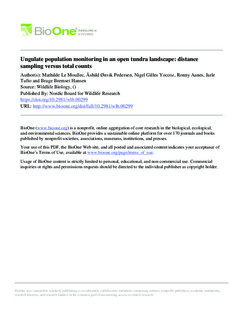| dc.contributor.author | Le Moullec, Mathilde | |
| dc.contributor.author | Pedersen, Åshild Ønvik | |
| dc.contributor.author | Yoccoz, Nigel Gilles | |
| dc.contributor.author | Aanes, Ronny | |
| dc.contributor.author | Tufto, Jarle | |
| dc.contributor.author | Hansen, Brage Bremset | |
| dc.date.accessioned | 2017-10-02T11:15:36Z | |
| dc.date.available | 2017-10-02T11:15:36Z | |
| dc.date.created | 2017-09-29T12:18:12Z | |
| dc.date.issued | 2017 | |
| dc.identifier.citation | Wildlife Biology. 2017, . | nb_NO |
| dc.identifier.issn | 0909-6396 | |
| dc.identifier.uri | http://hdl.handle.net/11250/2457702 | |
| dc.description.abstract | Researchers and wildlife managers strive for low bias and high precision (i.e. high accuracy) when estimating animal population sizes. Distance sampling is currently one of the most widely used monitoring methods. However, it relies on strict sampling designs and modeling assumptions that can be difficult to meet in the field. Here, we use data from two sub-populations of non-migratory wild Svalbard reindeer Rangifer tarandus platyrhynchus inhabiting flat, open and isolated coastal tundra plains, to demonstrate some challenges related to the distance sampling methodology. To achieve this, we compared distance sampling line transect estimates with repeated total population counts and combined available software tools (R packages unmarked, Distance and dsm) to fulfill the analytical requirements of small study sites in which large areas are surveyed relative to the study area size. Based on low variation among repeated total counts (CV = 0.02 - 0.06) and the virtual absence of false negatives and positives of marked animals, the total counts could be used as reference population sizes. Distance sampling estimates were not statistically different from the total count estimates. Our relatively large sample size of 143 observations enabled precise distance sampling abundance estimates (CV = 0.16 - 0.26) compared with other studies in the wild. However, capturing the processes shaping population dynamics would likely require even higher sampling effort or other, more resource demanding monitoring tools, such as total counts or mark-recapture. In this type of ecosystem, distance sampling nevertheless represents a cost-effective tool suitable for ‘population state’ assessment and studies of large-scale spatial distribution patterns. Our study stresses the importance of choosing the appropriate analytical tools and estimating the accuracy of the monitoring methods that are used to achieve specific scientific, management or conservation goals. | nb_NO |
| dc.language.iso | eng | nb_NO |
| dc.publisher | Nordic Board for Wildlife Research | nb_NO |
| dc.rights | Navngivelse 4.0 Internasjonal | * |
| dc.rights.uri | http://creativecommons.org/licenses/by/4.0/deed.no | * |
| dc.title | Ungulate population monitoring in an open tundra landscape:distance sampling versus total counts | nb_NO |
| dc.type | Journal article | nb_NO |
| dc.type | Peer reviewed | nb_NO |
| dc.description.version | publishedVersion | nb_NO |
| dc.source.pagenumber | 11 | nb_NO |
| dc.source.journal | Wildlife Biology | nb_NO |
| dc.identifier.doi | 10.2981/wlb.00299 | |
| dc.identifier.cristin | 1500379 | |
| dc.description.localcode | © 2017 The Authors. This work is licensed under the terms of a Creative Commons Attribution 4.0 International License (CC-BY) < http://creativecommons.org/licenses/by/4.0/ >. The license permits use, distribution and reproduction in any medium, provided the original work is properly cited. | nb_NO |
| cristin.unitcode | 194,66,10,0 | |
| cristin.unitcode | 194,63,15,0 | |
| cristin.unitname | Institutt for biologi | |
| cristin.unitname | Institutt for matematiske fag | |
| cristin.ispublished | true | |
| cristin.fulltext | original | |
| cristin.qualitycode | 1 | |

